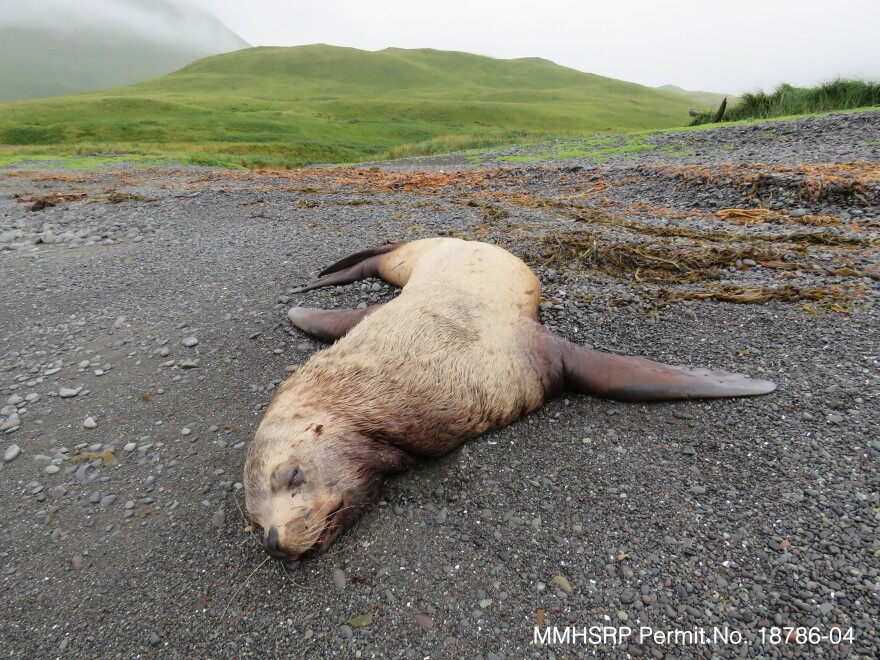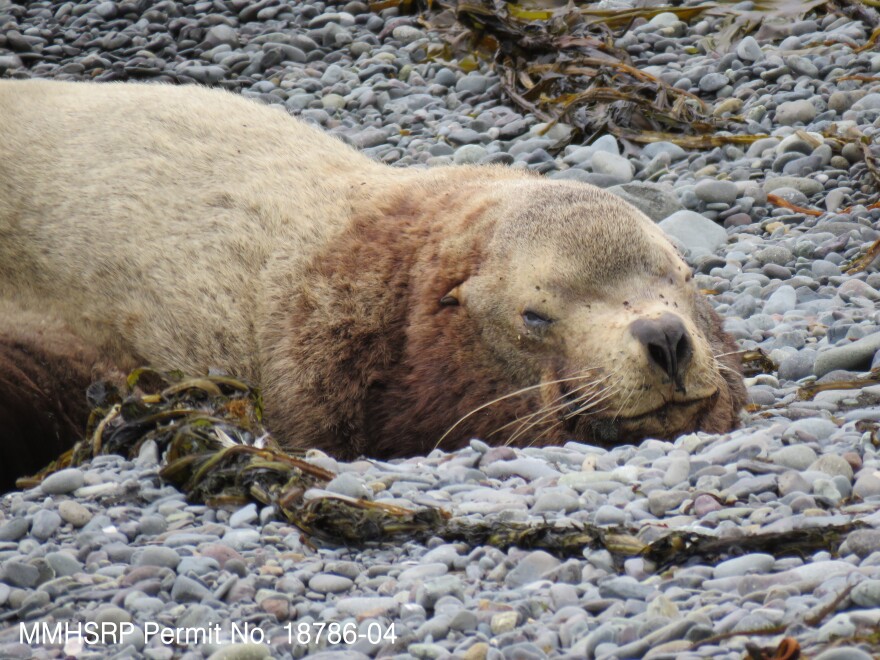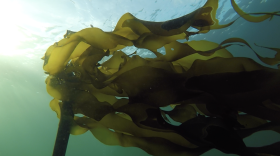A Steller sea lion in poor health was sighted at Morris Cove in Unalaska over the weekend, prompting biologists to observe the adult male until it died early in the week.
"It's really unusual to have sea lions hauling out on the soft sanded beaches," said Melissa Good, a marine advisory agent with Alaska Sea Grant. "We often see them hauled out on the marker buoys or on some of the rocky points where they have rookeries or haul out areas. But we very rarely see them hauled out on a beach, especially here near town."

Good said the large male wasn't acting right — he wasn't holding his head up straight or reacting to the things going on around him, and his hip bones were protruding, indicating he didn't have much blubber on his bones.
The Steller sea lion weighed about 1,500 pounds, according to Good, which, she said, is actually on the small end for adult males — which can weigh in at over 2,000 pounds.
"It's typical for them to lose a lot of weight over the summer, because the large males spend their summers hauled out with harems of females," she said. "And they're guarding the females all summer long and not eating. So they end up losing a lot of their body weight. But I would think that they'd have a little bit more fat on them, and this guy was really skinny."

Good reported the animal to the Alaska SeaLife Center and to the Marine Mammal Stranding Network— a program through NOAA Fisheries that responds to sick, injured, stranded, or dead marine mammals.
Officials with the program say they've recently been receiving more reports of Steller sea lions hauling out on beaches in poor condition, but have been unable to retrieve the animals for research — largely because they're in remote areas — and therefore still don't know what's causing the increase in sick or injured animals.
Because of unexplained widespread population declines in Alaska, Steller sea lions were first listed under the Endangered Species Act in 1990. The eastern stock has since recovered and is no longer listed, but the western stock, which can be found west of Cape Suckling — near Chugach National Forest — through the Aleutian Islands and into Russian territory, remains endangered, according to NOAA Fisheries. Good hopes the male sea lion found in Unalaska will contribute to the research on why the largest of the eared seals aren't doing well in the western Aleutians.

On Tuesday, the Steller sea lion died, and Good, with support from four volunteers from the Alaska Department of Fish and Game and the Museum of the Aleutians, performed a four-hour necropsy — or animal autopsy — on the 1,500-pound male.
"We collected the head, we collected samples of the internal organs, skin, muscles, and blubber," said Good. "And then we were also able to collect the stomach with all of its contents, feces, and urine. And all of these samples will help us get an idea of what caused this guy's death."
The samples got shipped off island Wednesday morning to the state pathologist, who will be doing a full workup — looking for toxins, viruses, bacteria, and any other abnormalities. Good said she hopes to hear back about the results in a couple weeks, but said some of the more detailed analyses take time.

"My hope here is that it gives us insight into the broader population of our sea lions in this area," she said. "The species has been listed [as an endangered species] for several years. Some areas are continuing to decline within our region, some of the smaller populations are increasing, and others are stagnant. And we just don't know why we're not seeing big increases in Steller sea lions, and why that population continues to not rebound."
Good said if anyone sees a marine mammal in a strange spot, or that looks unhealthy, don't approach it. Instead, call the Marine Mammal Stranding Network on their 24-hour hotline at (877) 925-7773, and they will send a local responder to check it out.






